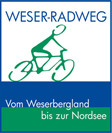Bremen, the hometown of the world-famous Town Musicians, is a trading and merchant city with all facets of historical and modern lifestyles, where history and tradition combine with high-tech and science to form an exciting overall picture. Landmarks of the Hanseatic city are the town hall, a UNESCO World Heritage Site, and the statue of Roland, which has watched over Bremen from the historic market square since 1404. In Bremen's oldest district, the Schnoor, cozy pubs, restaurants, and artisan businesses line up in historic buildings. From Bremen's Weser promenade, the Schlachte, the ride goes past the Beck & Co brewery, along the Neustädter harbor, and over the Ochtum flood barrier into the ADFC cycling travel region Wesermarsch, one of the largest contiguous grassland regions in Europe. The landscape here is characterized by black-and-white cows, lambs, horses, tractors, and half-timbered houses. In the so-called Melkhüs, you can taste this landscape: in the green wooden huts, countrywomen serve dairy delicacies from May to October.
Between Lemwerder and Berne, the influence of traditional shipyards prevails. Where plank ships and large sailing ships were built in the past, the highly modern companies today accept orders for luxury yachts and special ships from all over the world. To reach the seafaring town of Elsfleth on the Weser cycle path, cyclists must cross the Hunte bridge. The favorable location in the Weser-Hunte triangle and the proximity to the North Sea explain Elsfleth's connection to seafaring. In Haus Elsfleth, an old villa directly on the Weser, the Unterweser Shipping Museum informs about maritime development. As an alternative to the Hunte bridge, you can cycle over the idyllic Weser island "Elsflether Sand." However, the alternative route has the disadvantage that you have to use the Hunte flood barrier at the end, which can only be passed hourly. Further north in the port city of Brake, packing and trading houses testify to the significant maritime past. The tallest silo facilities in Europe shape the panorama. From the quay, you experience inland vessels and large freighters up close. A ferry sails to the island "Harriersand" with a bathing beach. At the quay stands the city's landmark, built in 1846 as an optical telegraph and home to the Unterweser Shipping Museum since 1960. In the pedestrian zone, in the house Borgstede & Becker built in 1808, you get insights into the shipping history of the region, as well as the first all-German navy and its commander Brommy.
From Brake, you follow the already heavily raised dyke to Rodenkirchen, where it is worth taking a look into the St. Matthew's Church, equipped with works by the woodcarver Ludwig Münstermann. Upon arrival at the train station in Nordenham, a detour to the pedestrian zone is recommended, where you are sure to meet an ox. The connection of the city with the animal goes back to the ox pier, from where oxen were shipped to London in the mid-19th century, thus bringing economic upswing to the rural region. At that time, no one suspected anything about the globally operating companies that now shape the city north bank. From the district of Blexen, the ferry goes to the opposite Weser side.
Alternatively, a detour to the North Sea peninsula Butjadingen is recommended. The North Sea lagoon in Burhave offers an ideal rest stop. So dive into the cool water of the seawater bathing lake, independent of ebb and flow.




